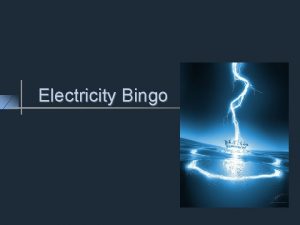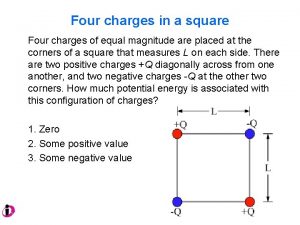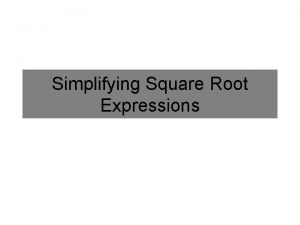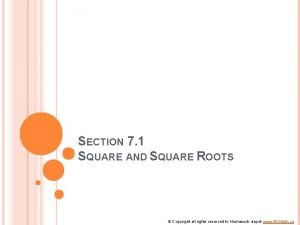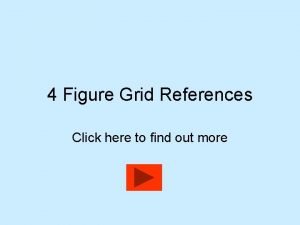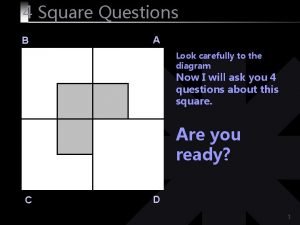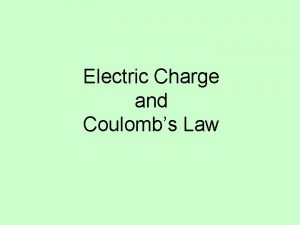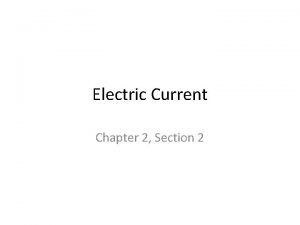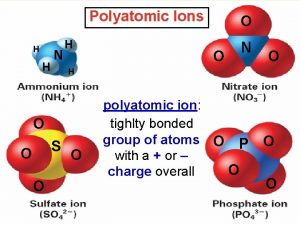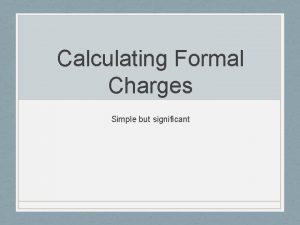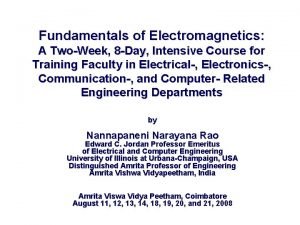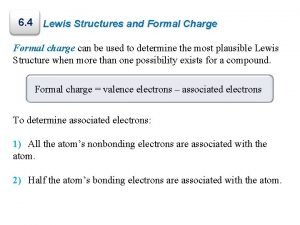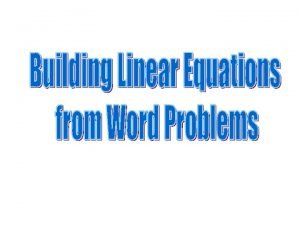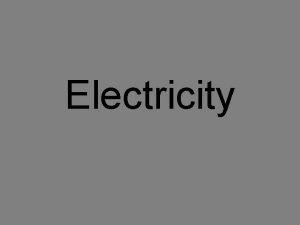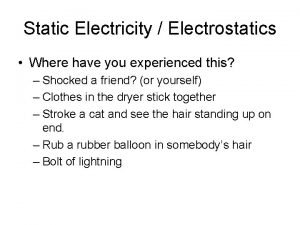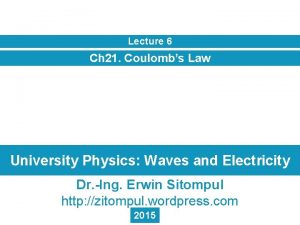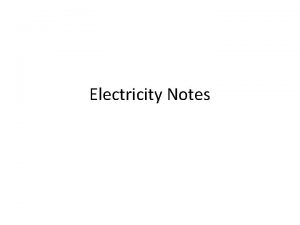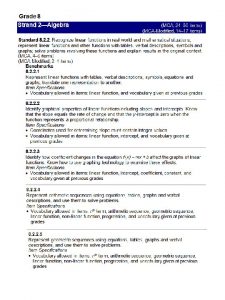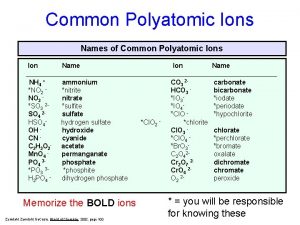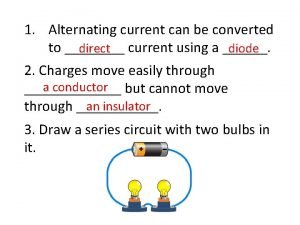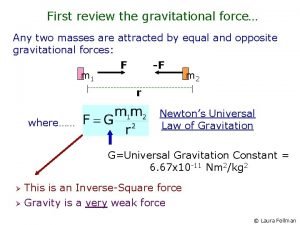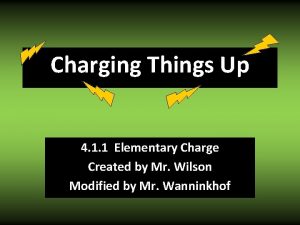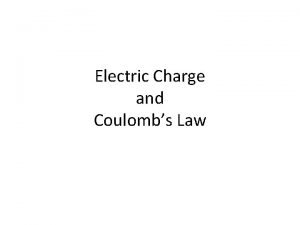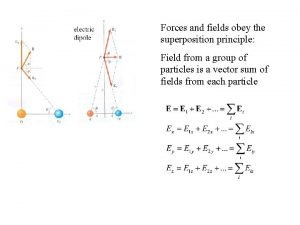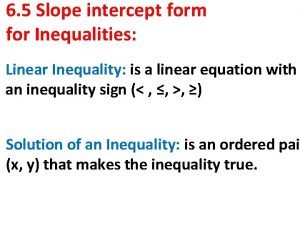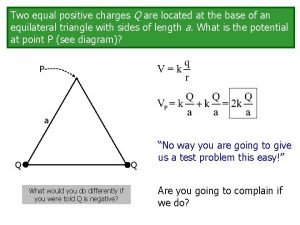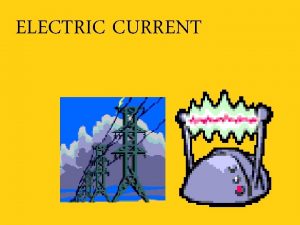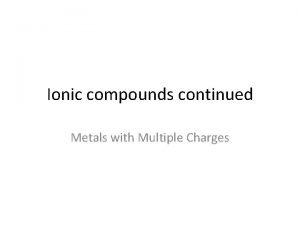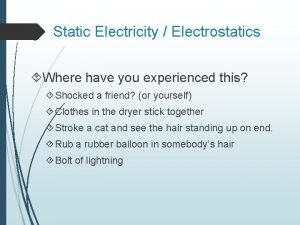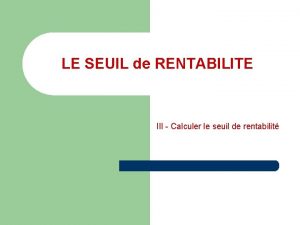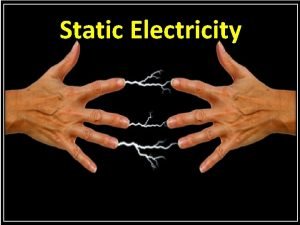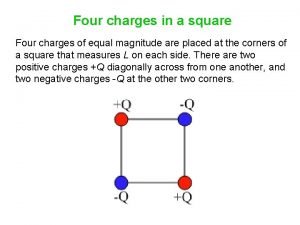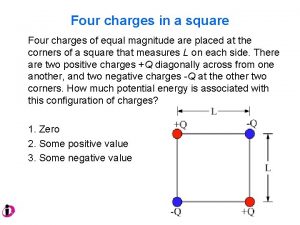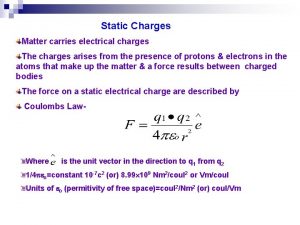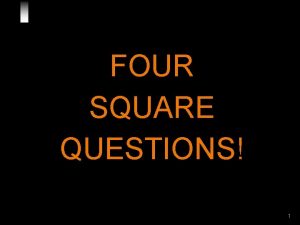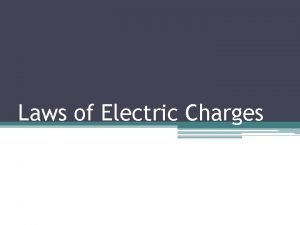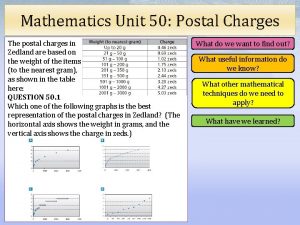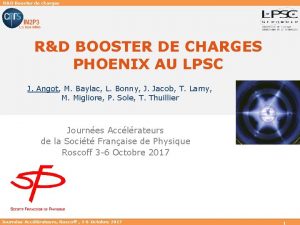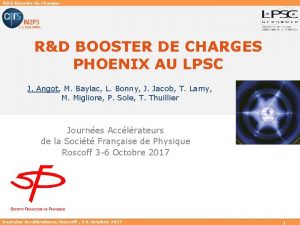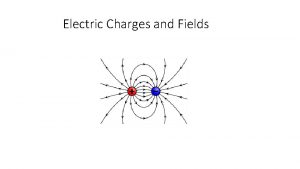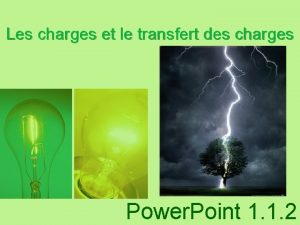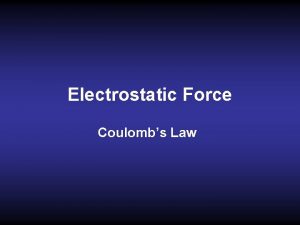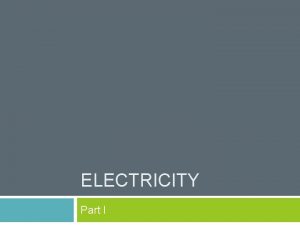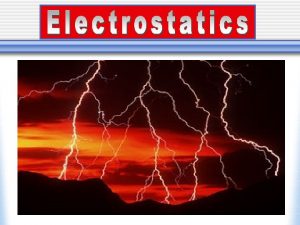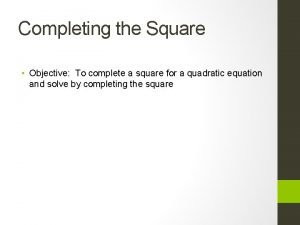Four charges in a square Four charges of































































- Slides: 63

Four charges in a square Four charges of equal magnitude are placed at the corners of a square that measures L on each side. There are two positive charges +Q diagonally across from one another, and two negative charges -Q at the other two corners. How much potential energy is associated with this configuration of charges? 1. Zero 2. Some positive value 3. Some negative value

Four charges in a square Determine how many ways you can pair up the charges. For each pair, write down the electric potential energy associated with the interaction. Add up all your terms to find the total potential energy. We have four terms that look like: And two terms that look like: When we add them up, do we get an overall positive, negative, or zero value?

Four charges in a square Determine how many ways you can pair up the charges. For each pair, write down the electric potential energy associated with the interaction. Add up all your terms to find the total potential energy. We have four terms that look like: And two terms that look like: When we add them up, do we get an overall positive, negative, or zero value? Negative

Electrostatic Energy in molecules A B Molecule A on the left has two negative charges. Molecule B on the right has three negative charges. Which molecule has the greater electrostatic energy? wikipedia

Electrostatic Energy in molecules A B Molecule A on the left has two negative charges. Molecule B on the right has three negative charges. Which molecule has the greater electrostatic energy? Molecule B: work is needed to add the third charge Bonus Organic Chem question: what are the two molecules?

Electrostatic Energy in molecules ADP ATP Molecule A on the left has two negative charges. Molecule B on the right has three negative charges. Which molecule has the greater electrostatic energy? Molecule B: work is needed to add the third charge Organic Chem question: what are the two molecules? ADP, ATP. [Adenosine Diphosphate; Adenosine Triphosphate] The basic energy ‘currency’ in biology.

Practical applications Do you know of any practical applications of capacitors? Capacitors are used anywhere charge needs to be stored temporarily, such as: • in computers, and in many circuits • storing the charge needed to light the flash in a camera • in timing applications, such as in pacemakers • in smoothing out non-constant electrical signals • as part of the circuits for metal detection systems, such as the ones you walk through in airports • in those no-battery flashlights and radios (some of these use a hand crank), where they act a little like batteries

A parallel-plate capacitor is a pair of identical conducting plates, each of area A, placed parallel to one another and separated by a distance d. With nothing between the plates, the capacitance is: is known as the permittivity of free space. We can also use the general equation, Q = C ΔV

Playing with a capacitor Take a parallel-plate capacitor and connect it to a power supply. The power supply sets the potential difference between the plates of the capacitor. While the capacitor is still connected to the power supply, the distance between the plates is increased. When this occurs, what happens to C, Q, and ΔV? 1. C decreases, Q decreases, and ΔV stays the same 2. C decreases, Q increases, and ΔV increases 3. C decreases, Q stays the same, and ΔV increases 4. All three decrease 5. None of the above

Playing with a capacitor Does anything stay the same?

Playing with a capacitor Does anything stay the same? Because the capacitor is still connected to the power supply, the potential difference can't change. Moving the plates further apart decreases the capacitance, because: To see what happens to the charge, look at Q = C ΔV. Decreasing C decreases the charge stored on the capacitor.

Playing with a capacitor, II Take a parallel-plate capacitor and connect it to a power supply. Then disconnect the capacitor from the power supply. After this, the distance between the plates is increased. When this occurs, what happens to C, Q, and ΔV? 1. C decreases, Q decreases, and ΔV stays the same 2. C decreases, Q increases, and ΔV increases 3. C decreases, Q stays the same, and ΔV increases 4. All three decrease 5. None of the above

Playing with a capacitor, II Does anything stay the same?

Playing with a capacitor, II Does anything stay the same? Because the charge is stranded on the capacitor plates, the charge cannot change. Moving the plates further apart decreases the capacitance, because: To see what happens to the potential difference, look at Q = C ΔV. Decreasing C while keeping the charge the same means that the potential difference increases. We can also get that from ΔV = Ed, with the field staying the same, because the field is produced by the charge.

Change? Our basic capacitor equations are: Q = C ΔV and, for a parallel-plate capacitor, The parallel-plate equation applies to a capacitor with vacuum (air is close enough) between the plates. Increase the area of each plate. The capacitance. . . 1. Increases 2. Decreases 3. Stays the same

Change? Capacitance is proportional to area, so increasing area increases capacitance.

Doubling the charge Our basic capacitor equations are: Q = C ΔV and, for a parallel-plate capacitor, The parallel-plate equation applies to a capacitor with vacuum (air is close enough) between the plates. Double the charge on each plate. The capacitance. . . 1. Increases 2. Decreases 3. Stays the same

Doubling the charge Based on Q = C ΔV, what happens to C when Q increases?

Doubling the charge Based on Q = C ΔV, what happens to C when Q increases? Who knows, if we don’t know what happens to potential difference? Start here, instead: Increasing Q does not change the capacitance at all. If the capacitance is constant, because it is determined by what the capacitor looks like, Q = C ΔV tells us that the potential difference across the capacitor doubles when the charge on each plate doubles.

Energy in a capacitor When we move a single charge q through a potential difference ΔV, its potential energy changes by q ΔV. Charging a capacitor involves moving a large number of charges from one capacitor plate to another. If ΔV is the final potential difference on the capacitor, and Q is the magnitude of the final charge on each plate, the energy stored in the capacitor is: The factor of 1/2 is because, on average, the charges were moved through a potential difference of 1/2 ΔV. Using Q = C ΔV, the energy stored in a capacitor can be written as:

Discharging a capacitor “WARNING: the energy stored in this capacitor is lethal. ” Let’s work out how much our 8 μF capacitor has when it has a potential difference of 4000 V. Then we’ll discharge it with a well-insulated screwdriver (don’t try this at home). The factor of 10 -6 in the capacitance cancels the factor of 10002, so we get: That doesn’t sound like enough to kill you, but I would not want to discharge the capacitor with my hand!

Dielectrics When a material (generally an insulator) is inserted into a capacitor, we call the material a dielectric. Adding a dielectric allows the capacitor to store more charge for a given potential difference. When a dielectric is inserted into a charged capacitor, the dielectric is polarized by the field. The electric field from the dielectric will partially cancel the electric field from the charge on the capacitor plates. If the capacitor is connected to a battery at the time, the battery is able to store more charge on the capacitor, bringing the field back to its original value.

The dielectric constant Every material has a dielectric constant κ that tells you how effective the dielectric is at increasing the amount of charge stored. E 0 is the field without the dielectric. Enet is the field with the dielectric. For a parallel-plate capacitor containing a dielectric, the capacitance is: In general, adding a dielectric to a capacitor increases the capacitance by a factor of κ.

The dielectric constant of a conductor What is the dielectric constant of a conductor? 1. Zero 2. Infinity 3. This question makes no sense – a dielectric is an insulator, so a conductor does not have a dielectric constant.

The dielectric constant of a conductor What is the net electric field inside a conductor that is exposed to an external field?

The dielectric constant of a conductor What is the net electric field inside a conductor that is exposed to an external field? Enet is zero inside a conductor (in static equilibrium, at least) so the dielectric constant is infinite. An infinite dielectric constant implies an infinite capacitance, which implies an ability to store infinite charge. So, why don’t we fill the space between capacitor plates with conducting material?

The dielectric constant of a conductor What is the net electric field inside a conductor that is exposed to an external field? Enet is zero inside a conductor (in static equilibrium, at least) so the dielectric constant is infinite. An infinite dielectric constant implies an infinite capacitance, which implies an ability to store infinite charge. So, why don’t we fill the space between capacitor plates with conducting material? Because that would short out the capacitor – it would provide a conducting path for the electrons to move from the negative plate to the positive plate.

Playing with a dielectric A capacitor is charged by connecting it to a power supply. The connections to the power supply are removed, and then a piece of dielectric is inserted between the plates. Which of the following is true? 1. The charge on the plates increases, as does the potential difference. 2. The charge on the plates increases, while the potential difference stays constant. 3. The charge on the plates stays the same, while the potential difference increases. 4. The charge on the plates stays the same, while the potential difference decreases. 5. Neither the charge nor the potential difference changes.

Playing with a dielectric Does anything stay the same?

Playing with a dielectric Does anything stay the same? Because the charge is stranded on the capacitor plates, the charge cannot change. Adding the dielectric increases the capacitance by a factor of κ. To see what happens to the potential difference, look at Q = C ΔV. Increasing C while keeping the charge the same means that the potential difference decreases. We can also get that from ΔV = Ed, with the field being reduced by the presence of the dielectric.

Energy and dielectrics The energy stored in a capacitor is still given by: Consider a capacitor with nothing between the plates. The capacitor is charged by connecting it to a battery, but the connections to the battery are then removed. When a dielectric is added to the capacitor, what happens to the stored energy? 1. The energy increases 2. The energy decreases 3. Energy is conserved! The energy stays the same.

Energy and dielectrics With the battery connections removed, the charge on the capacitor is constant. Adding the dielectric then increases the capacitance. From the equation, we see that adding the dielectric decreases the energy. Where does it go? If you then pull the dielectric out of the capacitor, the energy in the capacitor goes back up again. Where did it come from?

Energy and dielectrics With the battery connections removed, the charge on the capacitor is constant. Adding the dielectric then increases the capacitance. From the equation, we see that adding the dielectric decreases the energy. Where does it go? If you then pull the dielectric out of the capacitor, the energy in the capacitor goes back up again. Where did it come from? The side of the dielectric that is closest to the positive capacitor plate is negatively charged; the side closest to the negative plate is positively charged – the dielectric is attracted to the capacitor. The capacitor does work pulling the dielectric in, and you do work pulling it back out.

A field inside a conductor We’re now starting a new part of the course, in which we look at circuits. Let’s start with a look at a microscopic model of how electrons move in a wire. Simulation Any wire is a conductor, and thus it has conduction electrons that move about randomly, much like gas molecules in an ideal gas. When a battery is connected to the wire, we get a non-zero field inside the conductor (this is a dynamic equilibrium situation) that imposes a small drift velocity on top of the random motion.

Electric current, I, is the rate at which charge flows. Note that positive charge flowing in one direction is equivalent to an equal amount of negative charge flowing in the opposite direction. In most cases electrons, which are negative, do the flowing, but current is defined to be in the direction of positive charge flow (this is Ben Franklin’s fault). In the previous simulation, the electric field set up by the battery causes a net flow of charge.

Doubling the current The simulation shows a sequence of positive charges +q flowing to the right with a speed v. Which of the following corresponds to a doubling of the current? 1. Twice as many charges going right at v 2. Same number of charges going right at 2 v 3. Add -q charges going right at v 4. Add -q charges going left at v 5. Both 1 and 2 6. 1, 2 and 3 7. 1, 2 and 4 8. 1 and 3 9. 1 and 4

Doubling the current Which corresponds to a doubling of the current? 1. Twice as many charges going right at v 2. Same number of charges going right at 2 v 3. Add -q charges going right at v 4. Add -q charges going left at v 5. Both 1 and 2 6. 1, 2 and 3 7. 1, 2 and 4 8. 1 and 3 9. 1 and 4

Flipping a switch When a light switch on a wall is turned on, how long (on average) does it take an electron in the wire right next to the switch to reach the filament in the light bulb? Is it almost instantaneous, or could it be a minute or even more? Simulation

Flipping a switch The drift velocities of electrons in wires are typically 1 mm/s or less. Since a wall switch is usually a meter or more from the light bulb, the time for an average electron to drift from the switch to the bulb can be a few minutes. On the other hand, the bulb comes on almost instantaneously. This is because the electric field travels at around 108 m/s, so it is set up in the conductor almost instantaneously. There are conduction electrons throughout the circuit that acquire a drift velocity from the field and make the bulb glow when they pass through the filament.

Least current In the electrical circuit shown, at what point is the current the least? 1. Nowhere - the current is the same everywhere 2. The current is least near the positive terminal of the battery 3. The current is least between the lightbulbs 4. The current is least after the second lightbulb 5. The current is least near the negative terminal of the battery

An analogy with fluids In a fluid system • water flows because a pump maintains a pressure difference • the current (how quickly the fluid flows) depends on both the pressure difference and on the overall resistance to flow in the set of pipes • energy can be extracted from the fluid to do work (e. g. , turn a water wheel) Simulation

An analogy with fluids In an electrical system • charge flows because a battery maintains a potential difference • the current (how quickly the charge flows) depends on both the potential difference and on the overall resistance to flow in the circuit • energy can be extracted from the charges to do work (e. g. , light a bulb)

How a battery works A battery is an entire electron manufacturing process. A chemical reaction frees up electrons at the negative electrode. These flow through the circuit to the positive electrode, where another chemical reaction recycles the electrons. The electrodes are used up in this process and waste products are produced. This is why batteries run out. In a rechargable battery, the chemical reactions are run in reverse to repair the electrodes. That can only be done so many times. Fuel cells are like batteries where raw materials are continually added, and waste products are constantly removed.

A lead-acid battery A lead acid battery consists of two electrodes, one made from lead and the other from lead dioxide, immersed in a solution of sulfuric acid. The chemical reaction that takes place at the lead electrode liberates electrons, so that's the negative terminal: The electrons travel through the circuit to the positive terminal, where they are recycled in the reaction: To maintain the reactions, H+ ions must flow from the negative terminal to the positive terminal.

20. 2 Ohm’s Law The resistance (R) is defined as the ratio of the voltage ΔV applied across a piece of material to the current I through the material.

20. 2 Ohm’s Law OHM’S LAW The ratio ΔV/I is a constant, where ΔV is the voltage applied across a piece of material and I is the current through the material: SI Unit of Resistance: volt/ampere (V/A) = ohm (Ω)

20. 2 Ohm’s Law To the extent that a wire or an electrical device offers resistance to electrical flow, it is called a resistor. Ohm’s Law generally applies to standard resistors, but not, as you will see in the lab, to light bulbs.

20. 2 Ohm’s Law Example : A Flashlight The filament in a light bulb is a resistor in the form of a thin piece of wire. The wire becomes hot enough to emit light because of the current in it. The flashlight uses two 1. 5 -V batteries to provide a current of 0. 40 A in the filament. Determine the resistance of the glowing filament.

20. 2 Ohm’s Law Example : A Flashlight The filament in a light bulb is a resistor in the form of a thin piece of wire. The wire becomes hot enough to emit light because of the current in it. The flashlight uses two 1. 5 -V batteries to provide a current of 0. 40 A in the filament. Determine the resistance of the glowing filament.

Electrical resistance For many materials (e. g. metals, salt solutions), Ohm's Law is valid. The resistance, R, is a measure of how difficult it is for charges to flow. The resistance of a object depends on its length L, cross-sectional area A, and the resistivity r, a number that depends on the material: The unit for resistance is the ohm (W).

20. 3 Resistance and Resistivity values cover an incredibly wide range

20. 3 Resistance and Resistivity Impedance Plethysmography. Measuring small changes in resistance reflect changes in the volume of blood, which is a good conductor. Used as an indicator for venous thrombosis

20. 3 Resistance and Resistivity Resistance changes with temperature coefficient of resistivity

20. 4 Electric Power Suppose some charge emerges from a battery and the potential difference between the battery terminals is ΔV. energy power time Units: Joules/sec or Watts Called “Joule heating” in resistors. Question: The bottom of your laptop is rather hot when the computer is on. Why is that?

20. 4 Electric Power ELECTRIC POWER When there is current in a circuit as a result of a voltage, the electric power delivered to the circuit is: SI Unit of Power: watt (W) Many electrical devices are essentially resistors:

Understanding your electric bill The electric company bills you for the amount of _____ you use each month. They measure this in units of ________. How much does 1 of these units cost?

Understanding your electric bill The electric company bills you for the amount of energy you use each month. They measure this in units of ________. How much does 1 of these units cost?

Understanding your electric bill The electric company bills you for the amount of energy you use each month. They measure this in units of kilowatt-hours (k. W h). How much does 1 of these units cost?

Understanding your electric bill The electric company bills you for the amount of energy you use each month. They measure this in units of kilowatt-hours (k. W h). How much does 1 of these units cost? Approximately 10 cents. How many joules is 1 k. W h?

Understanding your electric bill The electric company bills you for the amount of energy you use each month. They measure this in units of kilowatt-hours (k. W h). How much does 1 of these units cost? Approximately 10 cents. How many joules is 1 k. W h?

The cost of power Here’s how to find the total cost of operating something electrical: Cost = (Power rating in k. W) x (number of hours it's running) x (cost per k. W-h)

The cost of watching TV The average household in the U. S. has a television on for about 3 hours every day. About how much does this cost every day? 1. 1 cent 2. 10 cents 3. $1 4. $10

The cost of watching TV Looked up on a TV – power rating of 330 W = 0. 330 k. W Cost = (Power rating in k. W) x (number of hours it's running) x (cost per k. W-h) Cost = 0. 33 k. W x 3 h x 10 cents/(k. W h) = 10 cents (or so). Compare this to the $$$$ it costs to go to the movie theater.
 Like charges blank and opposite charges blank
Like charges blank and opposite charges blank Charges in a square
Charges in a square Square numbers up to 12
Square numbers up to 12 Square roots
Square roots Cube nimbers
Cube nimbers Square root of 75 simplified
Square root of 75 simplified Square root times square root
Square root times square root Foil method biology
Foil method biology The area of a square is 144144144 square centimeters.
The area of a square is 144144144 square centimeters. 4 figure grid
4 figure grid Playing 4 square
Playing 4 square Four square writing examples
Four square writing examples 4 square graphic organizer
4 square graphic organizer Four square notes
Four square notes Four square questions
Four square questions Four square writing examples
Four square writing examples Four square question
Four square question Shape with one side
Shape with one side 4 eyes assessment
4 eyes assessment N fundamental charges
N fundamental charges Potential energy of a system of charges
Potential energy of a system of charges A material through which charges cannot flow easily
A material through which charges cannot flow easily Polyatomic ion chart
Polyatomic ion chart How to calculate formal charge?
How to calculate formal charge? Surface charges
Surface charges How to determine formal charge
How to determine formal charge 35 - 17
35 - 17 Partial positive and negative charges
Partial positive and negative charges Distributive property symbols
Distributive property symbols A daycare center charges a $75 enrollment fee
A daycare center charges a $75 enrollment fee Opposite charges attract.
Opposite charges attract. Like charges attract or repel
Like charges attract or repel Three point charges are arranged along the x-axis
Three point charges are arranged along the x-axis Term used to describe extreme, reckless charges
Term used to describe extreme, reckless charges Land use certificate meaning
Land use certificate meaning Oedipus the king episode 2 summary
Oedipus the king episode 2 summary Types of charges
Types of charges Way leave permission
Way leave permission Polyatomic ions list
Polyatomic ions list Server and cloud enrollment
Server and cloud enrollment A landscaping company charges
A landscaping company charges Co42- ion name
Co42- ion name The law of charges
The law of charges Pertes de charges singulières
Pertes de charges singulières Effects of gravitational force
Effects of gravitational force Elementary charge ev
Elementary charge ev Late charges in front office
Late charges in front office Bader charge analysis vasp
Bader charge analysis vasp Electric charges of the same sign
Electric charges of the same sign Charges periodic table
Charges periodic table Coulomb's law
Coulomb's law Cahier des charges logistique
Cahier des charges logistique Electric field superposition
Electric field superposition Slope intercept inequality
Slope intercept inequality Polyatomic ions list with charges
Polyatomic ions list with charges Potential energy of two equal positive charges
Potential energy of two equal positive charges Charges of groups
Charges of groups Electric current is the movement of
Electric current is the movement of Elements with multiple charges
Elements with multiple charges Like charges attract or repel
Like charges attract or repel Les charges fixe
Les charges fixe Static electricity
Static electricity Site intranet définition
Site intranet définition Electrostatic potential energy
Electrostatic potential energy
